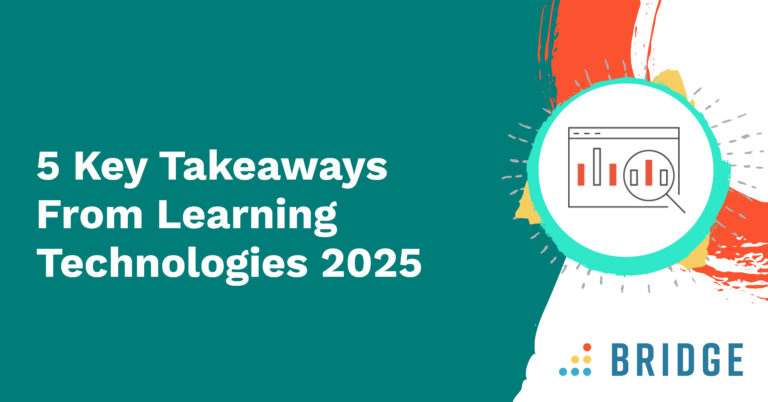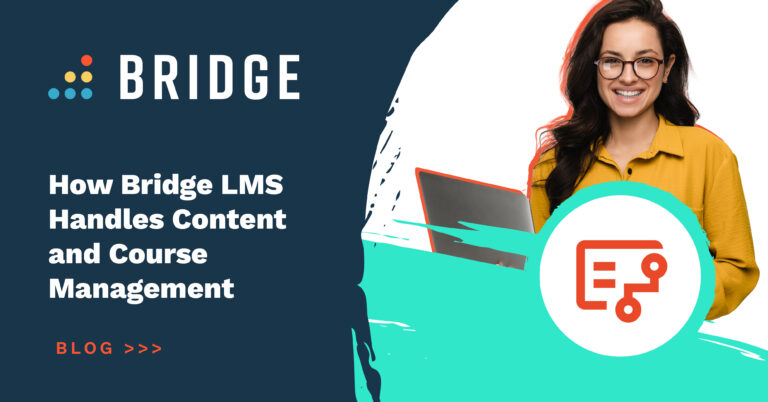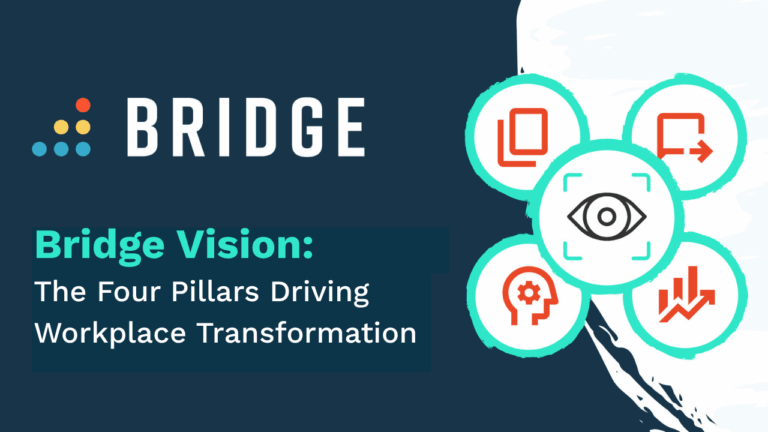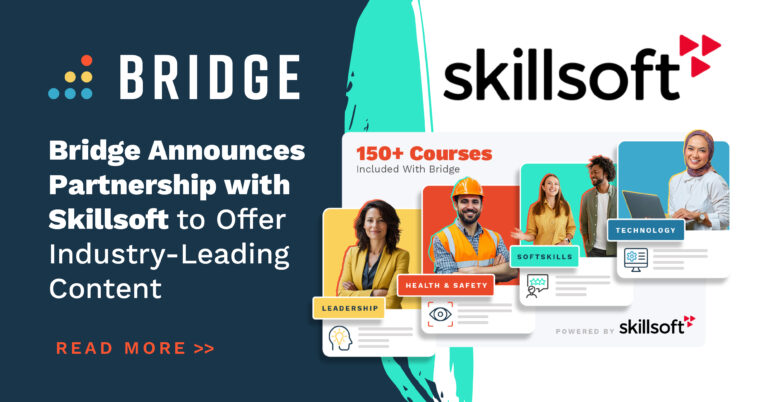Change is in the air for learning and development! Nowhere was this more evident than at the 2025 Learning Technologies conference and expo, which took place in London on April 23rd and 24th. This much-anticipated event boasted 200 L&D seminars on learning trends and topics, over 200 exhibitors of best-in-class learning technologies—including Bridge’s all-in-one learning and development platform—and more than 11,000 L&D professionals in attendance.
We had the pleasure of attending this two-day event and listening to some of the brightest thought leaders in L&D share insights from the conference on the profession, and how L&D practitioners can help their organizations achieve new levels of success.
Want to know why experts like Donald Taylor, Chair of Learning Technologies, and David Kelly, former CEO of The Learning Guild, think inevitable changes are on the horizon? Read on for their thoughts, along with four other key takeaways from the conference.
1) L&D Is at a Crossroads
If you're anything like our team here at Bridge, you'll have noticed that major changes have been brewing in L&D for the past couple of years. The shift to hybrid learning, changing expectations from our organizations due to economic conditions, and the unpredictable job market have steadily been increasing pressure on L&D professionals everywhere. These and other factors are urging us to reconsider our learning philosophies and how we work to achieve our organizations' development goals. Now, with AI in the mix, it means that profound change is inevitable.
Donald Taylor’s opening Learning Technologies address perfectly encapsulated what many of us in L&D have been feeling for the past few years: We're entering an era of profound change. AI will radically alter how we approach learning and development at every level, and L&D professionals must adapt.
David Kelly, former CEO of The Learning Guild, echoed this sentiment in the first keynote session of the conference, "Learning, Technology and Change." The question isn't if AI will change L&D, he said, but if we'll be able to change to keep up with it! David urged the audience to get better at asking questions to navigate technological changes in the industry.
The right questions can help you reframe challenges in terms of opportunities. Here are some of David's recommendations for questions to ask yourself or to use as discussion starters for getting a handle on the implications of AI or other new technologies:
How do I do what I do with this new technology?
AI has broad applications, but it's important to consider its daily impact on your role in L&D on a granular level. How will the technology impact your processes and workflows at your organization? Take an honest look at your daily habits and try to identify opportunities where this technology will empower you to do what only you—with your unique sets of experiences and skills—can do, but perhaps more efficiently or at a larger scale.
How does this tech enhance my team’s learning programs?
There are lots of opportunities for emerging technologies to take the learning experience to the next level. Bridge, for example, offers AI-powered skills tagging that can save you hours of research and manual admin. It’s crucial to work with stakeholders across your organization to identify opportunities where AI can be applied.
What makes my work uniquely human?
In an AI-saturated world, it makes sense to ask ourselves what makes our role as L&D experts uniquely human. When AI is used as a tool for efficiency, there may be plenty you can do with your free time to help your organization meet learning targets. At Bridge, we’re fans of skills communities to offer peer-to-peer learning or mentorship opportunities. This helps us empower our customers to offer personalized learning that employees can connect to on a human level.

2) To Prove Impact, L&D Practitioners Should Be Strategic Collaborators First
Amidst change, one thing has stayed constant: Organizations expect L&D teams to deliver measurable value. In fact, business impact may matter now more than ever. Organizations are under more and more pressure to demonstrate tangible value from any investment, and this includes learning. Tighter budgets in the current economic climate, changing workforce needs, and the impact of technologies may mean that you are under even more pressure to demonstrate ROI.
Kevin M. Yates, an L&D consultant who’s worked for brands including McDonald’s and Meta, understands this challenge. In his session, "Learning Evaluation," he encouraged L&D to steer away from one-dimensional metrics like hours of training completed, learner satisfaction scores of individual courses, or the volume of modules offered.
Instead, he urged L&D pros to identify the metrics that will prove business impact before undertaking any new training initiatives. But don't get learning and development tunnel vision! Valuable data for measuring impact may not obviously be related to learning. The most salient insights won't necessarily be contained within your LMS or in learning surveys, for example. This is because stakeholders in other functions may not understand how positive learning outcomes will impact the business's overarching goals. Kevin quipped that L&D professionals can think of themselves as detectives searching for the most pertinent business impact metrics across teams and departments.
Before undertaking any new learning efforts, consider collaborating with stakeholders in your organization to learn about the metrics that will be most salient for their business functions. Depending on the nature of your organization, these may include:
- Customer satisfaction scores
- Sales targets reached
- Productivity or efficiency KPIs
- Individual performance scores
- Fulfillment targets reached
- Staff engagement
Ask the right questions across your business to ensure you know the metrics that matter. This will allow you to present yourself as a strategic partner who always keeps the organization’s interests top of mind.
This sentiment was echoed across the conference, including by Dani Johnson, co-founder and principal analyst at RedThread Research. In the keynote session, "Learning, Technology and Change–a New Roadmap for a New Era," she argued that L&D professionals need to think like business people first, and learning experts second. Ultimately, many business leaders or decision-makers will have the bottom line of the organization top of mind at all times. L&D experts need to use strategic communication to help stakeholders outside of L&D understand how improved skills will impact the business as a whole.
Daniel J. Hulme, Chief AI Officer at WPP, would agree. In his talk, "The Future of Work, AI and Humanity," Daniel stressed the importance of thinking strategically to ensure business impact from technological investments. He emphasized that, despite the rapid pace of change, L&D pros don't need to be passive. You can directly impact the success of your organization, especially if you take an active role in using powerful technology to drive business goals forward. Strategically communicating with stakeholders across teams and departments is crucial for shaping the future you want to see for your learners.
Our very own Stephanie Kemp, Director, Enterprise Account Management, gave the audience some hands-on guidance on what strategic communication can look like in practice in her discussion on hybrid learning with Emma Kennedy, Operations Learning and Development Manager at Domino’s UK and Ireland. They emphasized that when launching any training program—hybrid learning included—understanding business targets should be the initial priority. Emma and Stephanie presented the audience with a workbook filled with questions to boost strategic communication with business stakeholders and turn challenges into clear problem-and-solution statements.
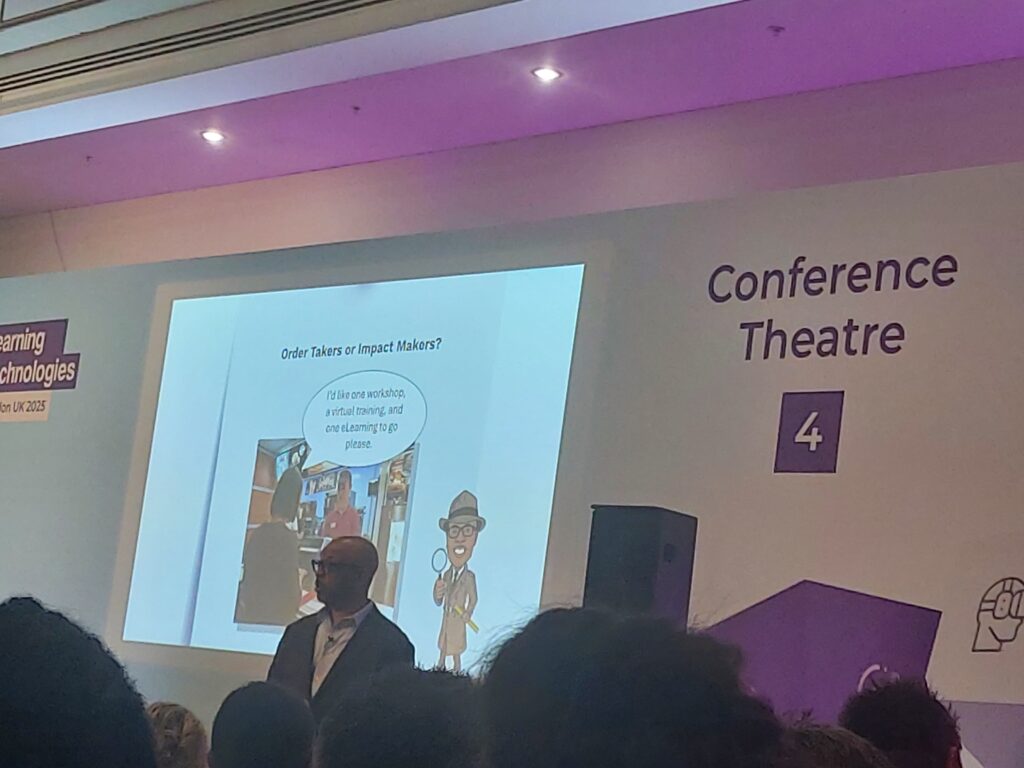
3) Mandatory Training Has Been Boring for Too Long
The importance of getting mandatory training right was echoed throughout the conference. Most learners will experience an organization's training for the first time when they complete their mandatory training. Leave a bad taste in their mouth and you may lose them forever! As Donald Taylor put it in his opening address, "Mandatory training is the shop window of L&D—it’s how they judge what we do."
It's no small wonder then, that many conference attendees were particularly interested in mandatory learning. Despite its importance, mandatory training remains one of the most challenging aspects for any learning professional. Q&A sessions throughout the conference were peppered with questions about ensuring completion, tracking compliance figures, and corralling unwilling learners.
“How can I get learners to complete anything when it's so boring?” one attendee lamented. Luckily, Caroline McCarthy, Senior Manager of Learning and Change Design, and Jonathan Gray, Change and Design Manager—both from Lloyds Banking Group—addressed this very question in their session, “Mandatory Training.”
Jonathan and Caroline advised the audience to offer streamlined learning experiences that motivate learners to actively engage with compliance courses instead of avoiding them. Some of their top tips and tricks include:
- Offer choice: Always make training available on multiple device types. Laptops, in-office desktops, and work-approved tablets are great, but smartphone-enabled training will be a game-changer! Learners want to complete their training wherever they are.
- Less is more: If learners open their training and see a block of text or rows and rows of modules, they’re more likely to click off the content as soon as they open it. Jonathan advised being ruthless about brevity. “If it’s not a legal requirement and if it isn’t necessary for safety, remove it,” he said.
- Keep it to 20 minutes or less: Employees today tend to be very busy and feel like they’re under a lot of pressure, but when they know that training won’t take them any more than 20 minutes, they’re more likely to squeeze it in between meetings and deadlines.
They also encouraged learning professionals to get creative when it comes to the content itself. Even though compliance training should be taken seriously, there's no reason that it should be boring. If you’re training learners about access control to an office building, for example, you can consider bringing theoretical training to life by having a colleague ‘go undercover’ and try to sneak into a building unauthorized. These kinds of interactive activities can be great material to make your compliance learning and mandatory training memorable.
Joseph Devlin, Professor of Cognitive Neuroscience at University College London, would agree with that. In his session, "Learning and the Mind," he explored the role of the neurotransmitter dopamine when it comes to learning. Our bodies release dopamine when we experience something enjoyable, and it’s a signal for us to keep coming back to that activity. This is why making learning fun and engaging, even when it’s about a serious topic, can motivate employees to keep coming back to their mandatory training.
A panel session exploring compliance—including Emma Kennedy, from Domino’s UK and Ireland—gave the audience a few great tips on bringing these principles to life.
Pannelists mentioned that L&D practitioners might struggle with negative perceptions of eLearning programs among staff who associate the LMSs their organizations use with uninspiring, mandatory training, which will deter voluntary engagement. Switching to a more visually engaging and intuitive LMS can break the negative association.
And the panellists had a few other tricks up their sleeve as well! They encouraged the audience to experiment with new media to help make compliance training feel more compelling. Why not inject some life into mandatory training topics by delivering them with exciting new methods, like podcasts frontline workers could listen to wherever they are? Also consider bringing your existing social media presence into the learning environment. That way, your learners can connect with your brand voice and feel at home across your organization's media landscape.
RELATED READING TO DOWNLOAD TODAY | ‘Compliance Training: Are You Checking Every Box?’

4) Making the Most of Staff Data Will Take Learning to the Next Level
L&D professionals wear many hats. You may be seen as a coach, a content curator, a learning strategist, or even a change agent. In today's data-rich environment, it's vital that you add "data analyst" to your list of skills. In fact, Derek Mitchell, People Analytics Lead at Novo Nordisk, would argue it should be in every learning professional's top 10 skills.
In his session, “Data and Analytics,” Derek argued that making the most of data is essential for creating effective learning. Like Kevin M. Yates, Derek urged L&D professionals not to focus on data siloed within the L&D function when designing training programs.
Collecting data from across your business ecosystem may provide a clearer picture of what kind of training your employees need. To take just a few examples:
- Messaging platforms like Teams or Slack are full of employees asking one another their most burning questions.
- Productivity data reveals whether employees are staying on after hours and at risk of burnout.
- Performance data shows whether employees understand how to work towards their targets and feel able to meet them.
- Workplace systems like SharePoint reveal whether or not employees are educated about protocols and adhere to them consistently.
Making full use of this kind of employee data across departments can help you understand where skills are lacking in your organization and how you can help employees bridge those skills gaps. In other words, data is everywhere in your business—why not use it strategically?
That said, Derek would urge L&D to operate within the confines of GDPR (and other similar data standards), which allows for legitimate business applications for employee information, and use data to ensure that training programs strategically close skills gaps.
FREE FOR YOU TO DOWNLOAD | ‘How AI Can Power Talent Management’
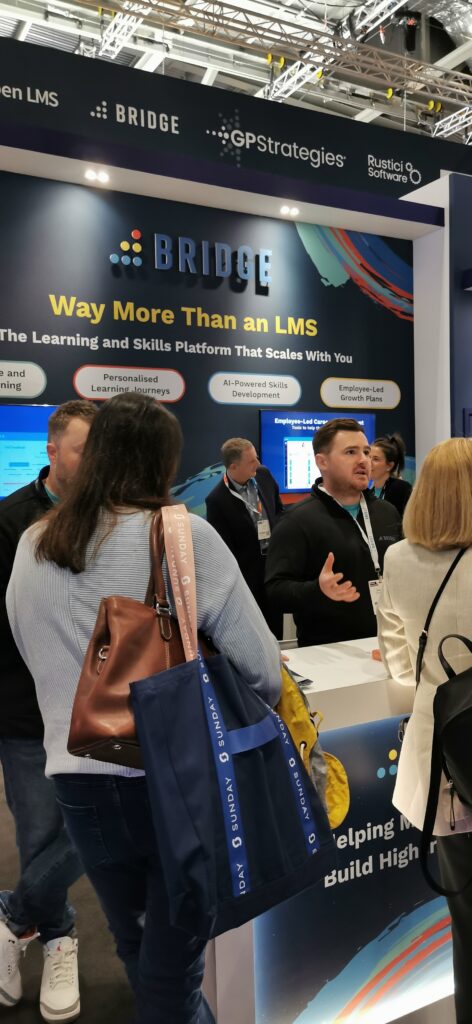
5) Yes, AI Is Everywhere (And Isn’t Going Anywhere!)
Throughout all the varied and engaging topics covered at the conference, AI was touched upon again and again. The event was buzzing with both optimism and a hint of apprehension about the opportunities and potential pitfalls this technology represents. Every professional will have a different approach to emerging technologies, but one thing's for sure: We must evolve our workflows, processes, and learning philosophies as technology changes, or we risk falling behind. As Professor Joseph Devlin put it in his talk about the mind, "AI is here to stay. The technology is not going anywhere. The question is, what will we do about it?"
The Platform You Need To Stay Ahead of Change
Staying on top of learning trends is important but you also need to put that theory into practice. And the right platform can help! Bridge is an all-in-one solution that can help you close skills gaps across teams and keep development on track for every learner in your organization. We’d love to talk about what we can do for you. Book a demo below and we’ll be in touch shortly.
